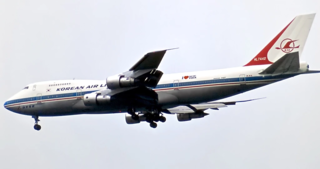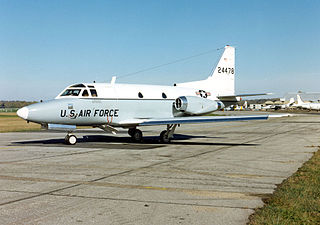See also
General:
Analogous incidents:
| RB-47 shootdown incident of 1960 | |
|---|---|
| Part of the Cold War | |
| Type | Aircraft shot down |
| Location | Barents Sea, near Kola Peninsula |
| Objective | Intercept American RB-47H spy aircraft |
| Date | 1 July 1960 |
| Executed by | Soviet Air Defense Forces |
| Casualties | 4 Americans killed |
On 1 July 1960, a United States RB-47H reconnaissance plane was shot down by the Soviet Air Defence Forces while performing signals intelligence in the Barents Sea, near the Kola Peninsula, off the Arctic coast of the Soviet Union. Four of the six crew members died. [1] The shootdown occurred exactly two months after the far better known U-2 shootdown involving Francis Gary Powers, and added to the tensions created by that incident.
The plane was part of the 55th Strategic Reconnaissance Wing and took off from RAF Brize Norton airbase in the UK. It was shot down by Soviet pilot Vasily Polyakov in a MiG-19. The US position was that the plane was in international waters, and this was later corroborated by information provided by spy Oleg Penkovsky. [2]
Three of the crewmen (reconnaissance officers Capt. Oscar Goforth, Capt. Dean Phillips, and Capt. Eugene Posa) were missing in action, and the remains of one other (aircraft commander Maj. Willard Palm) was recovered. [3] [4] The two survivors, navigator Captain John R. McKone and co-pilot Captain Freeman "Bruce" Olmstead, were picked up by Soviet fishing trawlers and held in Lubyanka prison in Moscow until immediately after the inauguration of newly-elected US President Kennedy, when they were released by Soviet leader Nikita Khrushchev as a goodwill gesture. [5] [6]
McKone and Olmstead appeared on the cover of the 3 February 1961 issue of Time magazine. [7] In his news conference on 21 April 1961, President Kennedy was asked if the dropping of charges against an accused Soviet spy was in exchange for the release of the RB-47 aviators. The president denied this. [8]
As a result of their involvement in the incident, Olmstead and McKone received POW medals in 1996 and Silver Star medals in 2004, as well as the Distinguished Flying Cross. [3] [4]
General:
Analogous incidents:

Korean Air Lines Flight 007 (KE007/KAL007) was a scheduled Korean Air Lines flight from New York City to Seoul via Anchorage, Alaska. On September 1, 1983, the flight was shot down by a Soviet Sukhoi Su-15 interceptor aircraft. The Boeing 747 airliner was en route from Anchorage to Seoul, but owing to a navigational mistake made by the crew, the airliner drifted from its planned route and flew through Soviet prohibited airspace. The Soviet Air Forces treated the unidentified aircraft as an intruding U.S. spy plane, and destroyed it with air-to-air missiles, after firing warning shots. The Korean airliner eventually crashed into the sea near Moneron Island west of Sakhalin in the Sea of Japan, killing all 269 passengers and crew aboard, including Larry McDonald, a United States representative. The Soviet Union found the wreckage under the sea two weeks later on September 15 and found the flight recorders in October, but this information was kept secret by the Soviet authorities until 1992, after the country's collapse.

The Boeing B-47 Stratojet is a retired American long-range, six-engined, turbojet-powered strategic bomber designed to fly at high subsonic speed and at high altitude to avoid enemy interceptor aircraft. The primary mission of the B-47 was as a nuclear bomber capable of striking targets within the Soviet Union.

On 1 May 1960, a United States U-2 spy plane was shot down by the Soviet Air Defence Forces while conducting photographic aerial reconnaissance deep inside Soviet territory. Flown by American pilot Francis Gary Powers, the aircraft had taken off from Peshawar, Pakistan, and crashed near Sverdlovsk, after being hit by a surface-to-air missile. Powers parachuted to the ground and was captured.

The North American B-45 Tornado was an early American jet bomber designed and manufactured by aircraft company North American Aviation. It has the distinction of being the first operational jet bomber to enter service with the United States Air Force (USAF), as well as the first multiengine jet bomber to be refueled in midair.

On 15 April 1969, a United States Navy Lockheed EC-121M Warning Star of Fleet Air Reconnaissance Squadron One (VQ-1) on a reconnaissance mission was shot down by a North Korean MiG-21 aircraft over the Sea of Japan. The plane crashed 90 nautical miles (167 km) off the North Korean coast and all 31 Americans on board were killed, which constitutes the largest single loss of U.S. aircrew during the Cold War era.

Kaleva was a civilian Junkers Ju 52 passenger and transport airplane belonging to the Finnish carrier Aero O/Y. On 14 June 1940, as Flight 1631 from Tallinn in Estonia to Helsinki in Finland, it was shot down over the Gulf of Finland by two combat aircraft of the Soviet military, killing all nine on board. The incident occurred during the Interim Peace between the Soviet Union and Finland, and at the outset of the Soviet occupation of Estonia. Kaleva was the second civilian passenger airplane ever to be attacked midair, and the first airliner in history to be shot down in flight, by hostile aircraft.

The 343d Reconnaissance Squadron is a United States Air Force unit part of the 55th Wing at Offutt Air Force Base, Nebraska. It operates the RC-135V/W Rivet Joint aircraft conducting reconnaissance missions.

After World War II, there were many instances of air-to-air combat between the Soviet Union and the United States.

On 28 January 1964, an unarmed T-39 Sabreliner aircraft of the United States Air Force (USAF) was shot down while on a training mission over Erfurt, East Germany, by a MiG-19 jet fighter of the Soviet Air Force. The occupants of the aircraft were Lieutenant Colonel Gerald K. Hannaford, Captain Donald Grant Millard, and Captain John F. Lorraine. All three died, becoming direct casualties of the Cold War in Europe.

The 1978 Iranian Chinook shootdown was an incident on 21 June 1978, when four Boeing CH-47 Chinooks of the Imperial Iranian Air Force strayed into Soviet airspace during a training mission, with the result being that two of them were shot down by the PVO.
HOMERUN was a secret US aerial reconnaissance operation against the USSR in 1956.

Between 1946 and 1960, the United States Air Force conducted aerial reconnaissance flights over the Soviet Union in order to determine the size, composition, and disposition of Soviet forces. Aircraft used included the Boeing B-47 Stratojet bomber and—from 1956—the Lockheed U-2 spy plane specifically designed for high-altitude reconnaissance flight. The overflight program was ended following the 1960 U-2 incident.

The Martin RB-57D Canberra was a specialized high-altitude strategic reconnaissance aircraft developed from the Martin B-57 Canberra tactical bomber, a license-built version of the English Electric Canberra. It was used by the United States Air Force during the 1950s prior to operational use of the Lockheed U-2.

The 1958 C-130 shootdown incident was the shooting down of an American Lockheed C-130A-II-LM reconnaissance aircraft which entered Soviet airspace during a mission in the region of Armenian SSR.
On 17 September 2018, the Israeli Air Force (IAF) conducted missile strikes against multiple targets in government-controlled western Syria. Syrian air defences responded to the Israeli fighter jets, accidentally shooting a Russian military Il-20, killing 15 crew aboard. Russia blamed Israel for the loss of its plane, accusing the IAF of "hiding behind the Russian aircraft", thereby putting it in the line of fire. The Israel Defense Forces accepted responsibility for the airstrikes the following day, but expressed sorrow regarding the loss of a Russian plane. The strikes occurred a few hours after a Russo-Turkish agreement to create a demilitarized zone around Idlib Governorate was achieved, which postponed an imminent offensive operation by Syria's forces and its allies.

Aleksandr Konstantinovich Gorovets was the deputy squadron commander of the 1st squadron of the 88th Guards Fighter Aviation Regiment in the Soviet Air Forces during the Second World War. He is credited with shooting down nine German aircraft in one mission during the Battle of Kursk, making him the record holder for most aerial victories during a sortie of any pilot in the Soviet Air Forces. He was posthumously awarded the title Hero of the Soviet Union on 28 September 1943.
White, William Lindsay (1962). The Little Toy Dog: The story of the two RB-47 flyers, Captain John R. McKone and Captain Freeman B. Olmstead. E.P. Dutton & Co. LCCN 62007801. OL 25622095M.